From Red Carpet Glamour to DIY Projects: Understanding the Magic Behind Fashion’s Most Dazzling Embellishment
Sequins add sparkle and glamour to any outfit. These small, shiny discs can transform a plain garment into a show-stopping piece. Sequins work best when balanced with simpler elements to avoid looking overdone.
You can wear sequins for both casual and formal occasions. For daytime, try pairing a sequined top with jeans and minimal accessories. At night, a fully sequined dress or jacket makes a bold statement. The key is mixing sequins with more understated pieces.
Sequins come in many colors and sizes. Clear sequins create a subtle shimmer, while colored ones add vibrant pops. When choosing sequined clothing, consider the overall look you want to achieve. A little sparkle goes a long way, so use sequins as an accent or focal point rather than covering yourself head-to-toe.
Table of Contents
Key Takeaways
- Sequins add glamour to outfits when balanced with simpler elements
- Mix sequined pieces with casual items for daytime wear
- Choose sequin colors and sizes based on the desired overall look
History of Sequins
Sequins have sparkled through human history for thousands of years. These shiny discs have adorned clothing and accessories, evolving from precious metals to modern synthetic materials.
Ancient Origins
Sequins trace back to ancient Egypt. Pharaohs wore gold discs sewn onto garments as symbols of wealth and power. King Tutankhamun’s tomb revealed clothing decorated with gold sequin-like ornaments.
In ancient civilizations, metal coins were often used as clothing decorations. This practice gave rise to the word “sequin,” which comes from the Arabic “sikka,” meaning “coin.”
Evolution through the Ages
By the 16th century, sequins had spread to Europe. Wealthy nobles adorned formal gowns and suits with polished metal disks. Skilled seamstresses spent hours hand-sewing these embellishments.
The 1930s saw a major shift in sequin production. Manufacturers began using gelatin to create lighter sequins. But these melted when wet or warm.
Acetate sequins soon replaced gelatin versions. These plastic sequins were durable and came in many colors. The new material made sequins more affordable and widely available.
Today, sequins come in countless shapes, sizes, and materials. They add sparkle to fashion, costumes, and accessories around the world.
Types of Sequins
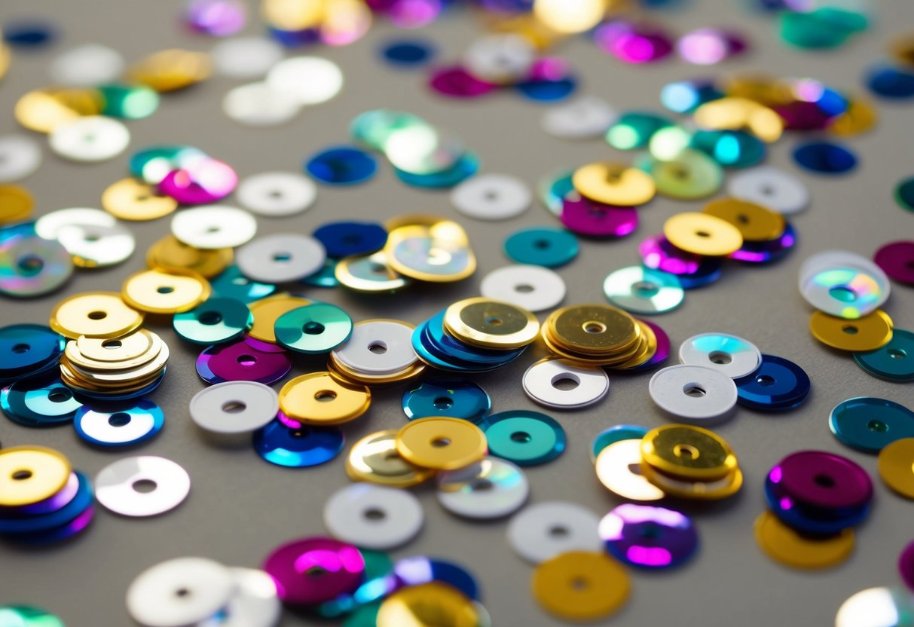
Sequins come in diverse materials, shapes, and sizes to suit different fashion and craft needs. These shiny embellishments can transform any garment or project with their sparkle and glamour.
Material Variations
Sequins are made from various materials. Plastic sequins are common and affordable. They come in many colors and finishes. Metal sequins offer a more luxurious look. They can be made of aluminum, brass, or other metals.
Vinyl sequins are durable and flexible. They work well for dance costumes. Glass sequins provide the most sparkle. But they are fragile and mostly used for special occasions.
Some sequins are eco-friendly. These are made from recycled materials or biodegradable substances. They appeal to environmentally conscious crafters and designers.
Shapes and Sizes
Sequins come in many shapes. Round sequins are the most popular. They reflect light well and are easy to sew. Square sequins create a modern, geometric look. Flower-shaped sequins add a feminine touch to designs.
Sizes range from tiny 2mm sequins to large 20mm ones. Small sequins work well for subtle shine. Large sequins make bold statements. Some sequins are flat, while others are slightly cupped. Cupped sequins catch more light and appear brighter.
Special shapes like stars, hearts, and holiday motifs are available for themed projects. These add fun and whimsy to crafts and clothing.
Manufacturing Process
Sequin manufacturing involves multiple steps to create the shiny, decorative discs. The process combines design, materials, and specialized techniques.
Design and Creation
Sequin designs start with selecting the base material, usually plastic or metal. Machines punch out small circular shapes from large sheets. The size and shape can vary based on the desired look.
Laser cutting is another method used for more intricate designs. This allows for custom shapes beyond basic circles.
Some manufacturers use molds to create sequins. Liquid plastic is poured into the molds and left to harden. This method works well for unique 3D shapes.
Coloring and Finishing
After cutting, sequins go through coloring processes. Many are dipped in dye baths to add vibrant hues. Metallic finishes often use vapor deposition, where metal coats the surface in a vacuum chamber.
Heat treatments help set colors and increase durability. Some sequins get extra coatings for shine or to prevent scratching.
The final step involves sorting and packaging. Machines separate sequins by size and color. They’re then packaged for shipping to clothing makers and craft stores.
Application Techniques
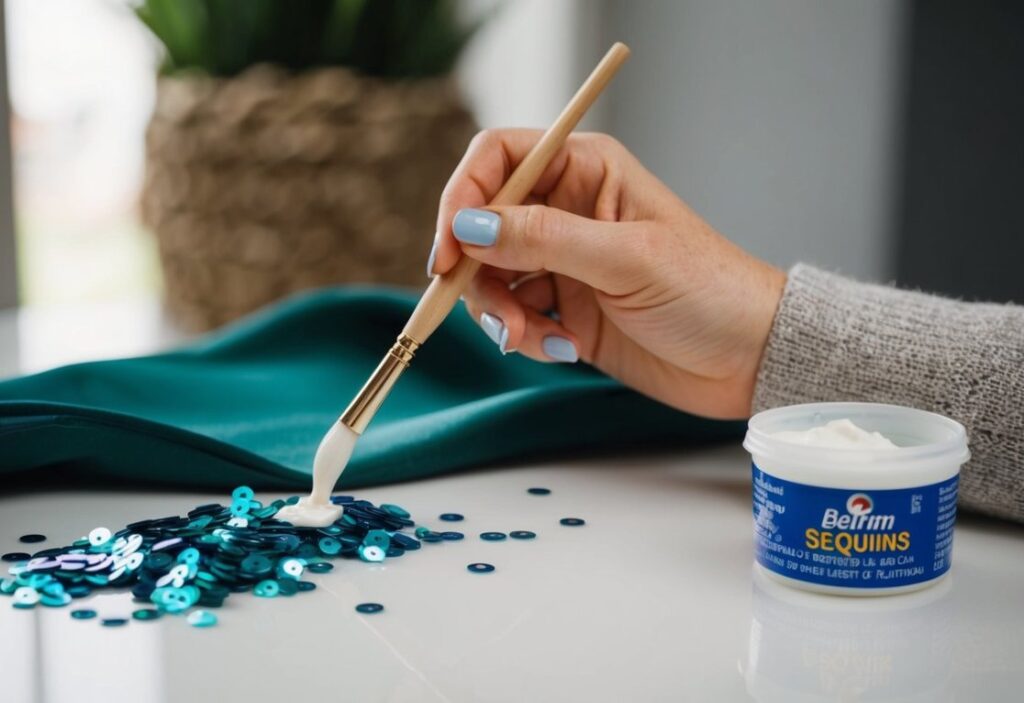
Sequins can be added to fabric using different methods. The two main ways are sewing them on by hand or machine, and using glue or adhesives.
Sewing and Attaching
Sewing sequins gives a secure, long-lasting finish. Use a fine needle and thread that matches the sequin color. For hand sewing, the seed stitch works well. Pass the needle through the sequin’s center hole and back through the fabric.
Machine sewing is faster for large areas. Use a special sequin foot attachment. Sew in rows, overlapping edges slightly. Go slow to keep sequins lined up neatly.
For loose sequins, make a small knot. Push the needle up through the fabric, add the sequin, then back down. Repeat for each sequin.
Adhesive Methods
Glue offers a quick way to attach sequins without sewing. Use fabric glue or a hot glue gun. Put a small dot of glue on the fabric. Press the sequin onto the glue dot with tweezers or a pencil eraser.
Work in small sections so the glue doesn’t dry too fast. Let each area dry fully before moving on. This stops sequins from falling off.
Fabric glue works best for a few sequins. Hot glue is good for larger areas but can be messy. Both methods work well for temporary designs or quick fixes.
Fashion and Design
Sequins add sparkle and glamour to clothing and accessories. They come in many colors and sizes, letting designers create eye-catching looks. Sequins can dress up casual outfits or make formal wear dazzle.
Sequins in Clothing
Sequin dresses shine at formal events. Designers use them for red carpet gowns and wedding attire. But sequins work for everyday fashion too. A sequin top can jazz up jeans for a night out. Sequin jackets or skirts make bold statement pieces.
Sequin placement matters in design. All-over sequins create a dramatic effect. Scattered sequins add subtle shine. Some clothes mix sequins with other fabrics for contrast.
Color choice affects a sequin garment’s look. Silver and gold sequins feel classic. Bright colors make bolder statements. Black sequins offer elegance with edge.
Accessorizing with Sequins
Sequin accessories let people try the trend in small doses. Sequin bags catch the light and draw attention. They range from tiny clutches to large totes. Sequin shoes, from flats to heels, add sparkle to any outfit.
Sequin jewelry makes necks, wrists and ears shine. Necklaces, bracelets and earrings come in sequin styles. Hair accessories with sequins add flair to updos or loose styles.
For subtle shine, look for clothes with sequin trim or patches. A sequin collar or pocket adds interest without overdoing it. Sequin belts cinch waists while catching eyes.
Care and Maintenance
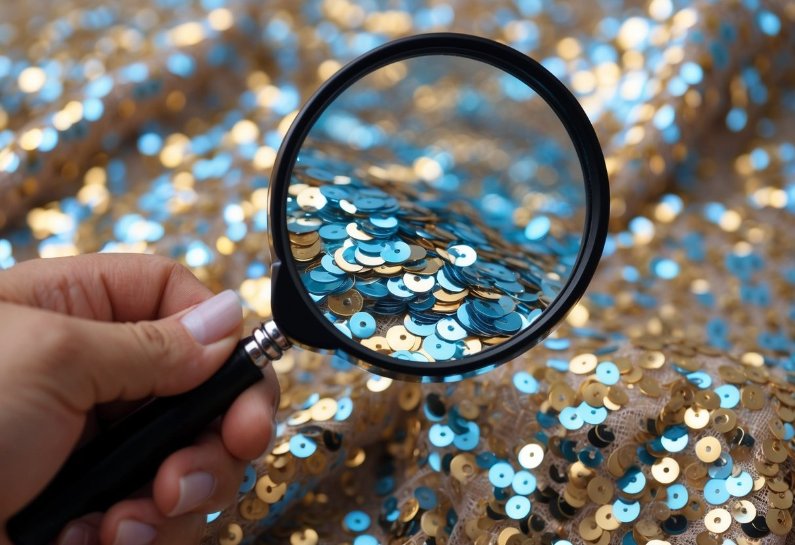
Proper care keeps sequin garments sparkling. Regular upkeep prevents damage and extends the life of these eye-catching pieces.
Cleaning Tips
Hand wash sequin items in cool water with mild detergent. Gently swish the garment and avoid rubbing or wringing. Rinse thoroughly and lay flat to dry.
For stubborn stains, dab with a soft cloth and soapy water. Don’t scrub, as this can loosen sequins.
Dry cleaning is often the safest option for delicate sequin pieces. Check the care label first.
Steam sequin clothes to remove wrinkles. Avoid direct iron contact, which can melt or damage sequins.
Spot clean small areas with a damp cloth for quick touch-ups between full cleanings.
Storage Solutions
Store sequin items flat or hung in a cool, dry place away from sunlight. This prevents fading and keeps sequins from warping.
Turn garments inside out before storing to protect the sequins. Place tissue paper between folds to prevent snagging.
Use padded hangers for sequin dresses and tops. Avoid wire hangers that can snag or misshape items.
Cover stored sequin pieces with breathable garment bags. This shields them from dust while allowing air flow.
Check stored items periodically for loose sequins. Reattach any that have come loose to prevent further loss.
Environmental Impact
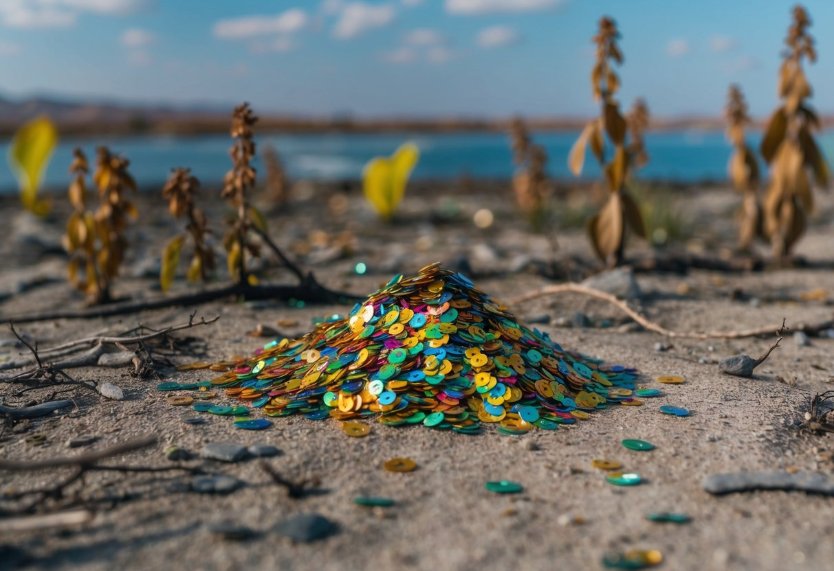
Sequins pose significant challenges for sustainability and pollution. Their production and disposal contribute to environmental harm in multiple ways.
Sustainability Concerns
Sequins are typically made from petroleum-based plastics like PVC. These materials contain toxic chemicals, including carcinogens and hormone disruptors. The production process requires high energy use and creates pollution.
Most sequins are not biodegradable. They end up in landfills or pollute oceans and beaches. Microplastics from sequins can harm marine life and enter the food chain.
The fashion industry already has a large carbon footprint. It accounts for 10% of global carbon emissions. Adding sequins to clothing makes garments even less eco-friendly.
Eco-Friendly Alternatives
Some companies are developing more sustainable sequin options. These include biodegradable sequins made from plant-based materials.
Recycled plastic sequins offer another alternative. They reuse existing plastics rather than creating new ones.
Renting or buying secondhand sequined items reduces demand for new production. Choosing classic styles that stay in fashion longer also helps.
Some designers use alternative embellishments. Beads made from glass or wood provide sparkle with less environmental impact.
Trends and Popularity
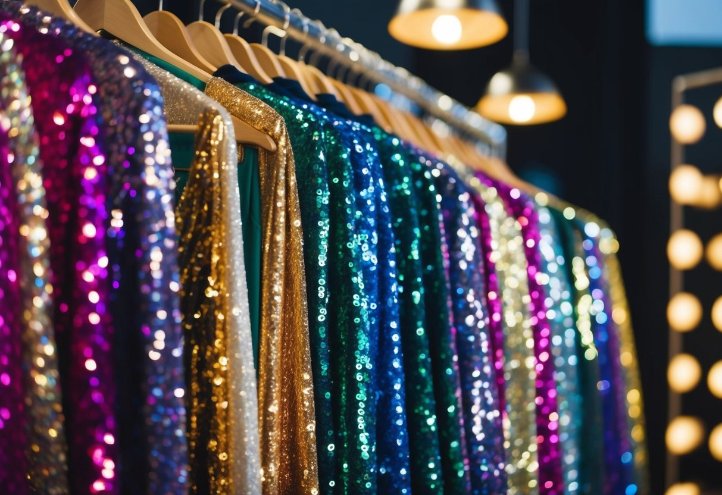
Sequins have long been a favorite in fashion, with their sparkle and shine adding glamour to outfits. Their use has evolved over time, from formal occasions to everyday wear.
Historical Significance in Fashion
Sequins first gained popularity in the 1920s during the Art Deco era. Flappers wore dresses covered in sequins for a dazzling effect on the dance floor. In the 1950s and 60s, sequins became a staple of Hollywood glamour. Stars like Marilyn Monroe and Elizabeth Taylor often wore sequined gowns on the red carpet.
The 1970s disco era saw a surge in sequin use. Dance floors glittered with sequined tops, dresses, and jumpsuits. The 1980s continued this trend with bold, colorful sequined designs.
Contemporary Uses
Today, sequins are more versatile than ever. They’re not just for special events anymore. Designers are using sequins in daytime looks, casual wear, and even accessories.
Larger sequins are trending, creating bold and eye-catching effects. Some brands are exploring eco-friendly options, using plant-based materials instead of plastic.
For summer 2024, sequins are expected to be big. Fashion influencers are styling sequined pieces for everyday wear. Expect to see sequined tops paired with jeans or sequined skirts with simple tees.
Hot pants with sequins are gaining popularity, especially among younger crowds. Their popularity is set to rise by 14% from July to September 2025.
Frequently Asked Questions
Sequins can add sparkle to any project, but working with them requires some specific techniques. Here are answers to common questions about using sequins effectively.
What are the necessary steps to apply sequins without sewing?
Fabric glue works well for attaching sequins without sewing. Clean the fabric surface first. Apply a small dot of glue to each sequin. Press firmly onto the fabric. Allow to dry completely before wearing or washing.
Can sequins be sewn with a sewing machine, and if so, how?
Yes, sequins can be sewn by machine. Use a special sequin foot attachment. Choose a zigzag stitch. Sew slowly to avoid breaking needles. Test on scrap fabric first to get the right settings.
What are some techniques for sewing sequins and beads together?
Use strong thread like nylon or polyester. Knot the thread securely. Sew through the holes of sequins and beads. Add reinforcement stitches for durability. Work in small sections to keep the design neat.
What is the quickest method to sew on sequins?
Pre-strung sequin trim is fastest. Pin the trim in place. Use a straight stitch to secure it. For individual sequins, use a needle threader to speed up the process. Work in rows for efficiency.
What type of needle is required for sewing sequins to fabric?
Use a sharp, fine needle. Size 9 or 10 works well. Beading needles are ideal. They’re thin enough to pass through sequin holes easily. Change needles often, as sequins can dull them quickly.
Are there specific times when wearing sequins is considered inappropriate?
Sequins are often seen as formal or festive wear. They may be too flashy for conservative workplaces. Daytime casual events usually call for less sparkle. Consider the occasion and dress code before wearing sequins.
Related Post: Fabric 101: Essential Guide to Textile Types and Care

